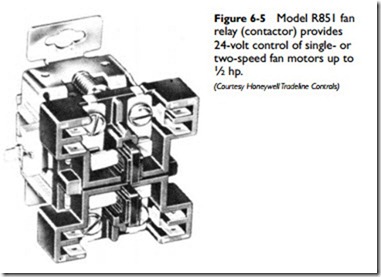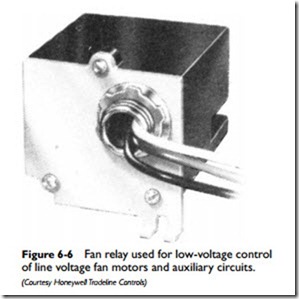Fan Relays
A fan relay is a primary controller designed to provide 24-volt circuit control of line voltage fan motors and auxiliary circuits in heating and/or cooling systems (see Figures 6-5 and 6-6). It also provides manual fan operation at any time by using the manual fan switch of the thermostat base.
Fan relays are available in a variety of different models based on the switching element contact position. The following are some examples:
• Single-pole, single-throw (SPST) switching element—both contacts normally open.
• Single-pole, double-throw (SPDT) switching element—one contact normally open and one normally closed.
• Double-pole, single-throw (DPST) switching element—one normally open main contact and one normally open auxiliary pole.
Fan relays are often used with multiple-speed fans to provide low-speed fan operation during the heating cycle and high-speed operation during the cooling cycle.
A 24-volt room thermostat is generally used to switch the fan relay controlling the indoor fan (120- or 240-volt AC power). In cooling systems, a second fan relay must be added if switching control of the condenser fan motor is desired.
The operation of a fan relay can be checked by applying power to the coil and listening for the click of the contacts closing or by testing for electrical continuity. If the fan relay does not operate, check the voltage to the coil.
Sometimes a fan will operate at low speed but not at high speed. Check the fan relay first. If it is not defective and is receiving proper voltage, the failure of the fan to operate at high speed may be caused by loose wiring or dirty contacts. The method used for cleaning relay contacts is described elsewhere in this chapter (see Cleaning Contactors).
A defective fan relay is also the occasional cause of compressor short cycling; however, this operating problem is more commonly traced to dirty air filters and other air movement restrictions on the low side of the compressor. These possible causes should be checked first.

